What Continent Is Argentina Loczted in What Controls the Price of Beef in Argentina Keeping It Low
- Research
- Open up Access
- Published:
Argentine regime policies: impacts on the beefiness sector
Agricultural and Food Economics book 5, Article number:1 (2017) Cite this commodity
Abstract
Beefiness is a staple food for Argentine consumers, and although the state has been a major exporter, the highest proportion of beef production is consumed in the domestic market. With rising inflation rates in the final 5 years, and given the beef prices' strong weight on the composition of the Consumer Price Index, the Argentine regime began taking measures to control it. They initially forced price agreements with members of the marketing and product chain and ended upward with a total ban on exports. The results were non as expected and caused serious distortions at dissimilar levels of the beefiness concatenation. This written report aimed to determine whether the affect on some economic and production variables would accept been unlike without such intervention. A VAR model was estimated in order to compare the observed behavior with intervention measures and estimated predictions with a theoretically complimentary market.
Background
The agri-food sector is very important to the Argentine economy, generating nigh 30% of the Gross Domestic Production (GDP) and 50% of its full exports (Obschatko 2012). The beef sector has been an outstanding component, generating 22% of the agronomical sector gross domestic production and 6% of the total manufacturing production (INDEC 2012).
Mostly, around three quarters of beefiness production has been consumed domestically, with the remaining volumes exported. Information technology immune positioning the country equally one of the larger exporters in the world market place situation, which changed in the final years as a result of several government measures. While beef exports between the years 1995 and 2005 averaged xv% of full beef production, the participation was reduced to 7% in 2014 (MINIAGRI 2015). From existence the world'southward third largest beef exporter, with 775,000 tons in 2005, the country descended to the 11th place, with 197,000 tons in 2014, well behind its neighbors, Brazil, Uruguay, and Paraguay (MINIAGRI 2015; COMTRADE 2016).
In the domestic marketplace, beefiness is considered a staple food and as such a key component of the family consumption basket; therefore, it monopolizes government attending both to ensure its availability to the entire population and to watch the impact it has on consumer price changes. Since beefiness carries a 4.5% weight in the Consumer Toll Index (CPI), the government became worried. This led information technology to have several improvised and abrupt short-term policy measures to keep prices under command since 2005.
Following the 2002 devaluation and economic crisis, the beef sector began a slow recovery. Initially, livestock and beef prices remained stable, simply later on, a sustained domestic and foreign need pushed them upwards. Domestically, beef demand got stronger basically as a result of an comeback in the population real income. Internationally, information technology was fueled by some emerging countries growth, large purchases by Russian federation and Chile, and the crisis of other suppliers from the mad cow disease. As a upshot, there was an excess of beef need which was rapidly reflected into domestic prices. Even so, by 2005, the exchange rate had tripled while boilerplate beef prices had only doubled (Melitsko et al. 2012).
The potent incidence on the CPI and the accelerating inflation rates moved the regime to intervene actively. Initially, in March 2005, government carried out a price agreement with the individual sector attempting in vain to adjourn the price rise; in August, it imposed a minimum slaughter weight for live animals with objective to increase the supply of heavier animals; in Nov, the target was to restrict strange sales, elevating export taxes to 15%, and eliminating the export reimbursements of indirect taxes (five%). In Jan 2006, an consign registry system (ROE) Footnote 1 was created. The government role in accuse of administering the system (ONCCA) Footnote 2 was given the power to extend an consign say-so for each shipment, as a precondition to the custom clearance. Delays and arbitrary objections were afterwards used as ways to interfere and discourage operations. Furthermore, in March 2006, beef exports were initially banned for 180 days. Afterwards on, a quantitative restriction policy was implemented, forcing beef packers to export only domestic market surpluses.
In 2007, to keep the system of "suggested maximum prices" to consumers, the authorities granted subsidies to feed lots to buy corn, policy which continued upwards to 2011 when the ONCCA was airtight, under strong suspicion of corruption.
By 2010–2012, the negative effects of those measures at unlike levels of the beef chain were visible. For example, cattle stock dropped by more than 10 million heads between 2007 and 2012 (severe droughts and floods added significantly to this pass up) and domestic cattle price increased by 300% and beef consumer price by more than 400% betwixt 2005 and 2012 (IPCVA 2015). General aggrandizement rate in Argentina for this period was approximately 319% Footnote iii. Many cattle farms liquidated their cattle stocks and turned to soybean production, and 20% of the number of beef packers closed or suspended their businesses.
The performance did not improve much during 2013 and 2014, with the domestic market place arresting 93.6% of all beef production, the highest percentage in 53 years. Product and export continued declining, and an estimated 130 slaughter plants and 15,600 jobs disappeared Footnote iv.
Almost a decade passed since the authorities intervention began, with various indicators detailing the adverse results of such economic policies on the beef sector. However, several questions remain: Would the results had been different without the strong government intervention? Would the evolution of sector variables, such equally retail prices, consign volumes, quantity produced, and per capita consumption, have been different without government intervention? What were the costs and benefits of the government intervention?
To essay an answer to these questions, this paper aims to approximate the difference of two different scenarios: one with actual data of what actually happened and another with a simulated one without regime intervention.
This paper is structured as follows. In the following section, the time serial method used to estimate the model is exposed. Then, the results of the model and the estimated impacts of the economic policies applied to the beef sector are calculated. Finally, in the concluding section, conclusions and implications of the results are presented.
Methods
The VAR model
Given the complexity of the beef marketplace in Argentina, it is interesting to analyze it from a multivariate perspective. In the assay of time series information, vector auto-regression models (VAR) have been widely used in empirical works. The VAR model was proposed past Sims (1980) as an culling to simultaneous equation models. The VAR processes are a generalization of multivariate autoregressive models (AR), where each variable is regressed on a gear up of others with several lags (Hamilton 1994; Enders 2009).
Following Becketti (2013), a univariate unproblematic model (AR) without exogenous variables can exist represented as
$$ {y}_t=u+{\varnothing}_1{y}_{t-ane}+\dots +{\varnothing}_p{y}_{t-p}+{\upepsilon}_t $$
compactly as
$$ \varnothing (50){y}_t=u+{\upepsilon}_t $$
Where y t is a office of a abiding (μ), p past values of t, and a random variable ε t . If we consider a vector together with endogenous variables
$$ {y}_t=\left[\begin{array}{c}\hfill {y}_{ane,t}\hfill \\ {}\hfill {y}_{2,t\ }\hfill \\ {}\hfill {y}_{three,t}\hfill \\ {}\hfill .\hfill \\ {}\hfill .\hfill \\ {}\hfill .\hfill \\ {}\hfill {y}_{north,t}\hfill \terminate{array}\right] $$
It can be modeled of northward elements equally a function of n abiding, y t past values of the vector p, and a vector of nε t random errors.
$$ {y}_t=u+{\Phi}_1{y}_{t-1}+ \dots +{\Phi}_p{y}_{t-p}+{\epsilon}_t $$
In this equation, μ are the chemical element north constant vector
$$ \boldsymbol{u}=\left[\begin{array}{c}\hfill {u}_1\hfill \\ {}\hfill {u}_2\hfill \\ {}\hfill .\hfill \\ {}\hfill .\hfill \\ {}\hfill .\hfill \\ {}\hfill {u}_p\hfill \stop{assortment}\right] $$
And,Φ I is a matrix of coefficients,
$$ {\varPhi}_i=\left[\brainstorm{array}{cccc}\hfill {\phi}_{i,\ 11}\hfill & \hfill {\phi}_{i,\ 12}\hfill & \hfill \dots \hfill & \hfill {\phi}_{i,\ 1n}\hfill \\ {}\hfill {\phi}_{i,\ 21}\hfill & \hfill {\phi}_{i,22}\hfill & \hfill \dots \hfill & \hfill {\phi}_{i,\ 2n}\hfill \\ {}\hfill .\hfill & \hfill .\hfill & \hfill \dots \hfill & \hfill .\hfill \\ {}\hfill .\hfill & \hfill .\hfill & \hfill \dots \hfill & \hfill .\hfill \\ {}\hfill .\hfill & \hfill .\hfill & \hfill \dots \hfill & \hfill .\hfill \\ {}\hfill {\phi}_{i,\ n1}\hfill & \hfill {\phi}_{i,n2}\hfill & \hfill \dots \hfill & \hfill {\phi}_{i,\ nn}\hfill \end{array}\correct] $$
And ε t is a vector of n elements of random errors
where
$$ E\left({\upepsilon}_{\boldsymbol{t}}\right)=0\kern1em \mathrm{y}\kern1em Due east\left({\upepsilon}_{\boldsymbol{t}}{\upepsilon}_{\boldsymbol{south}}^{\boldsymbol{\hbox{'}}}\right)=\left\{\begin{array}{c}\hfill \boldsymbol{\Sigma}, \kern1.75em t=s\hfill \\ {}\hfill \mathbf{0},\kern1.75em t\ne s\hfill \end{assortment}\right\} $$
existence Σ the variance-covariance matrix. Information technology is of import to note that the elements ε t could be contemporaneous correlated. As well, the VAR model tin exist written every bit a VAR with p lags in a more compact way
$$ \Phi (L)=I-{\Phi}_1(L)-\cdots -{\Phi}_p(Fifty) $$
whereΦ (50) is a matrix of polynomials in the lag operator. The number of lags to include in the VAR model is selected by some information criteria such equally Akaike'southward data criterion (AIC) or Schwarz's Bayesian information benchmark (SBIC). Other tests used to check the capability of the VAR model incorporate autocorrelation in the residuals (Lagranger multiplier) and a test for normality distribution in the disturbances (Jarque-Bera).
VAR model predictions can be performed directly, which tin be one-period alee or dynamic. In this work, more interesting results can be achieved carrying out dynamic predictions over a catamenia alee.
The variables used in the VAR model are the following: cattle prices (CP), total beefiness product (BP), per capita beefiness consumption (BC), volume of exported beef (EB), and the average retail prices (RP). Two exogenous variables are also added to the model: average beef consign prices (EP) and the domestic soybean prices (SP). Data were obtained from unlike sources. The cattle prices were obtained from Liniers Footnote 5 cattle marketing in Buenos Aires and expressed in Argentine pesos per kilogram (live weight basis). Total beef production (thousands of tons), per-capita beef consumption (kilograms per person), volume of beefiness exports (thousands of tons), beef prices at the retail level (Arg. pesos/kg), and boilerplate beef export prices (United states of america dollar per tons) were obtained from the Institute for the Promotion of Argentine Beef. Domestic soybean prices were taken from the Rosario Board of Trade. The information were monthly and comprised the menses from January 2003 to May 2014. Footnote 6 Although data were available for the mentioned period, VAR model was estimated only for the first years, from January 2003 to March 2006. It responded to the fact that the beef marketplace in Argentina operated like a more than competitive market during this period. Predictions of the VAR model for this span (2003–2006) were then used to compare information technology with the observed values in the 2d period (2006–2014) and to estimate the losses or gains resulting from regime intervention.
Results and discussion
Scenario with the bodily evolution of selected variables
Descriptive statistics of the main variables included in the model are shown in Table i for periods January 2003 to March 2006 and April 2006 to May 2014. The price information were deflated to values of June 2013 using the official price alphabetize published past the National Establish of Statistical and Census from 2003 to 2006 and so the Consumer Price Index published by the National Congress of Argentina. The reason of using both indexes is considering the official price index published by the National Institute of Statistical and Census became unreliable afterwards 2007.
Cattle monthly average toll was higher in the second period (Arg. $viii.eleven/kg.) compared to the first i (Arg.$7.06/kg), with a difference of virtually 15% between them. Monthly beefiness production showed like average monthly values in both periods and per-capita monthly beefiness consumption just a few differences betwixt both periods (61.78 kg/month, confronting 63.13 kg/month). Yet, there were pregnant differences in the average beef exports and retail domestic toll for both periods. In beef exports, Argentina exported in average a 27% less in the second menstruation when government controls were in identify (2006–2014), and also consumer paid approximately 23% more per kilogram in that period.
The behavior of the variables included in the VAR model is shown in Fig. one. Altogether, they illustrate the present scenario. In all of them, it is possible to observe the significant changes that occurred in the beef sector later 2010, with declines in product, exports, and per-capita consumption. In contrast, it is observed an increase in retail and beef cattle prices.
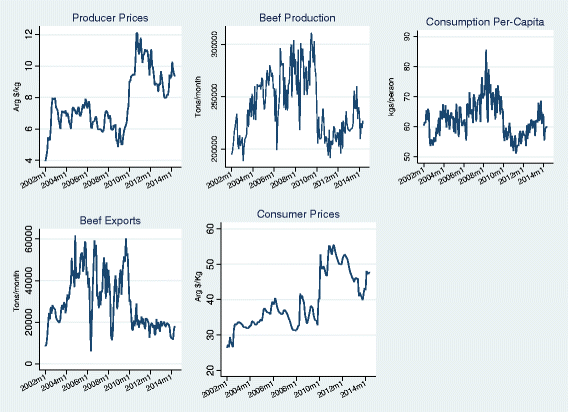
Variables used in VAR model
Results of VAR model
A model VAR of five equations was prepare with beefiness cattle price, beef production, per-capita beef consumption, retail beef price, and the volume of beef exports. Taking them as the beef market most relevant variables, their interactions permit modelling the market behavior in a reasonable manner and test the touch of sectorial economic policies. At the aforementioned fourth dimension, two exogenous variables were added to the model, such equally beef cuts' prices received by exporters and soybean toll. The first was taken equally exogenous considering Argentina is considered a toll-taker participant in the international beef market. In plough, the soybean toll was included considering soybean product is seen equally an alternative to livestock production in Argentine republic, competing for resources such as land and capital. Other exogenous variables were initially included in the model, for case, chicken and corn prices, with no significant differences in the results. In upshot, they were excluded in order to have a more parsimonious model.
The variables were tested for unit roots. Three types of tests are shown in Table two. The producer price, per capita consumption and beef export variables were stationaries according to the tests used. Yet, beef production and the average retail price simply showed evidence of existence stationary at the 10% level of statistical significance. Consequently, a VAR model with five variables was estimated by the given sample size.
The number of lags in the VAR model was determined according to unlike selection criteria. A model with four lags responded to the data Akaike (AIC) and information of Quinn (HQIC) criterion and only iii lags to the Schwarz Bayesian (SBIC) criterion. On this basis, a model with iii lags was estimated, since information technology ensured that residuals were uncorrelated, saving degrees of liberty and obtaining a more parsimonious model.
The coefficients of the VAR model for the menstruum January 2003 to March 2006 are shown in Tabular array 3. A total of eighteen coefficients were estimated in the system, including the exogenous variables. The coefficients showed a stationary process since the eigenvalues of the estimated VAR model were located inside the unit circumvolve.
Many of the VAR model coefficients were not statistically significant. Notwithstanding, reducing the lags to 1 or two generated a model with correlated residuals, and the Jarque-Bera exam rejected the zilch hypothesis of normal disturbances on residuals. Testing the lags in each equation of the VAR model, it was found that the first lag in the per-capita consumption equation was non significant, as well as the tertiary lag in the producer price and export beefiness equations. However, lags were significant when the VAR model equally a whole was considered Footnote 7.
The test of the Lagrange multiplier for residuals indicated no correlation at the i% level (Table 4).
Moreover, the Jarque-Bera examination did not pass up the null hypothesis of normal disturbances in all residuals (Table 5).
Based on the estimated coefficients of VAR model for the period 2003–2006, predictions were fabricated in social club to compare with observed values. Therefore, possible losses or gains generated by the effect of intervention measures were calculated between April 2006 and May 2014.
Scenario with predicted results
Predictions based on VAR model
Predictions nigh the price of the beef cattle started in Apr 2006, after one of the first pregnant measures imposed by the government banning beef exports for 180 days; prices were close to those observed. Later on, the model did not capture the pregnant rise that took place in the cattle price, although at the end of the period, the estimated values were very close to those observed. The greyness area shows 95% confidence intervals of dynamic predictions. The observed prices in full general remained within this area, except for the unusual ascension after the cattle stock liquidation in previous years, which was exacerbated by a severe flood in the year 2007 and drought in 2009. Forecasts too imply that if the marketplace had acted more freely, producer prices of beef cattle would had been more stable.
Forecasting beef production between 2006 and mid-2009, the model showed similar values to those observed, although with some discrepancies (Fig. two). Beefiness production would have been greater than the observed data, to reach values close to those observed for 2014. If nosotros compare the sum of observed values of beef production for the consummate period: Apr 2006 to May 2014, and that of the predicted values, we conclude that production would had been 4.15% higher in a market without such authorities intervention.
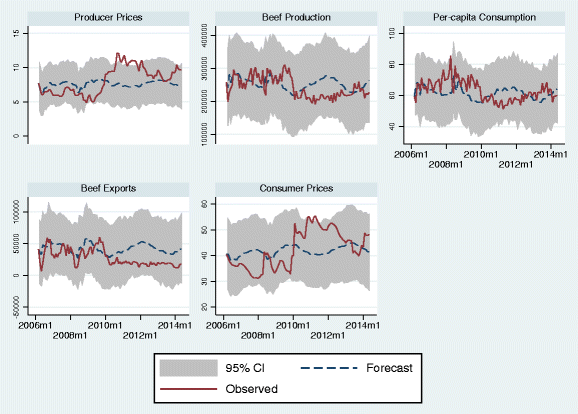
Dynamic forecasts
The model predicted stable values of per-capita beef consumption, differing from those observed, peculiarly in regard to its variability. In full general, consumption forecasts ranged from 52 kg per-capita to lxx kg per capita, showing a slight decreasing trend.
With respect to boilerplate retail prices of beef cuts, there are two distinctive periods. Before 2010, the model predicted prices slightly higher than those observed, while after 2010, retail prices were lower. In summary, predicted prices remained with a few changes, with a slight up trend.
Beef export forecasts showed higher values than those actually observed. Betwixt 2006 and up to mid-2009, the exported volumes were slightly higher, but in general shut to those observed. However, the exported volumes showed a wider difference for the flow after 2010.
A more detailed analysis of losses and gains on exports, domestic consumption, and producer prices is presented in the side by side sections.
Losses and gains from the intervention in the beef sector
Domestic consumption
One of the objectives defined by the regime intervention was to continue depression domestic prices, especially for food items. However, results from the model showed that it had a depression impact on retail beef cost. The average observed retail price was Arg. $42.six per kilogram, while the predicted without authorities intervention was Arg. $41.8 per kilogram. This suggests that even with drastic measures such as the barriers and bans to exports, authorities failed to go on depression beef retail price.
At the same time, an interpretation of what information technology would have been the values paid past consumers given the average monthly prices and the monthly consumption in the domestic market (full product minus total exports) without regime measures was done. Figure 3 shows that bodily consumer expenditure on beef compared to the predicted values was lower in the early years of imposed restrictions merely college afterward the twelvemonth 2010.
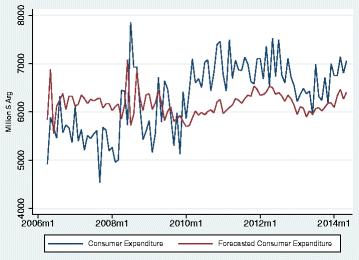
Total consumer expenditures in the domestic market
The sum of observed and predicted full consumer expenditures in the domestic market yielded a full value of Arg. $ 14,249 million (US$ 2673 million Footnote eight). It means that the consumer losses were very high, and it confirmed that agricultural policies applied to keep depression domestic prices did not achieve their objective.
Beef exports
The difference between beef exports and model predictions under government intervention for the period 2006–2013 was approximately 1.5 1000000 of tons. This means an boilerplate of 180,000 tons per twelvemonth or near fifteen,000 tons per month. Of those, 1.14 million of tons (252,325 tons a calendar month on average) export losses corresponded to the period with a stronger authorities intervention (2010–2014). Valued at prices received past exporters, the value loss of entire menstruum reached US$ 8000 1000000, of which US$ six.800 million belonged to 2010–2014.
Monthly beef exports predicted and observed are showed in Fig. iv, as well every bit the evolution of boilerplate prices. Losses have been college after 2010 when the government only authorized exports for approximately 20,000 ton per month, despite prevailing proficient prices in the international beef markets.
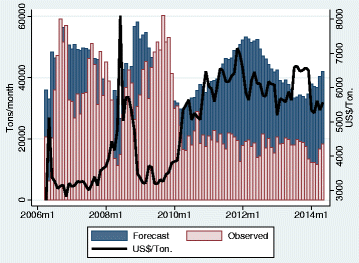
Beef export losses
Producer cattle prices
Predicted cattle prices were higher than observed ones before 2010 and lower in the flow 2010–2014. Before 2010, a potent cattle supply pushed cattle prices downward, and after 2010, the reverse occurred, cattle supply was reduced, increasing prices.
In order to examine whether producers income has been impacted by the interventionist policies, constructive and predicted income values were calculated (total production by cattle prices). For the period 2006–2014, the predicted producer income loss was Arg. $1470 million, which represented almost US$ 275 one thousand thousand. Figure 5 shows a clear difference between the real income and the predicted value past the VAR model before and afterward 2010. In the first period, the cattle producer sector transferred incomes to other sectors in the production and marketing concatenation; with the interventionist policies, cattle prices and producer income have been lower than without them. In the 2nd period, existent cattle prices increased more than predicted and and then did producers income.
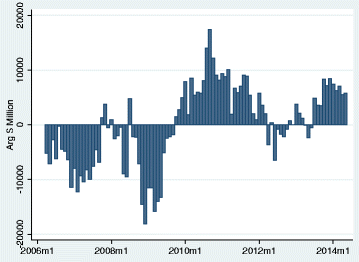
Divergence between observed and predicted beefiness product value
Evaluation of VAR forecast
In society to evaluate dynamic forecasts from VAR, we compared the functioning of VAR forecasts with predictions generated past other procedures. 3 techniques are used to compare to VAR forecasts Footnote ix: (a) elementary mean of the variables, (b) predictions from a random walk model, and (c) forecast provided past independent univariate time-series model for each variable of the model (Becketti 2013).
In Tabular array 6, it is displayed the root hateful of squared mistake (RMSE) obtained from pseudo out-of-sample forecasts for each of these methods and for the five endogenous variables of the VAR model. In full general, the VAR forecast is an comeback on forecast techniques, particularly compared with univariate time-series models. For producer cost, the relative performance of the VAR worsen as the forecast horizon increases, and for two-step-ahead forecast, for example, the RMSE of VAR forecast is 47% smaller than the RMSE of the hateful forecast, 34% larger than the RMSE of random walk forecast, and 46% smaller than the RMSE of the univariate AR forecast.
Conclusions
The objective of this paper has been to investigate the impacts of government policies on the beef sector in Argentina, particularly evaluating the effects of those measures over some variables such equally beef production, producer prices, beef exports, consumer prices, and domestic consumption.
The model used in this work has allowed estimating the theoretical losses generated by government economic measures that influenced beefiness exports, beef production, producer income, and prices paid by consumers.
After the 2002 crunch which affected the Argentine economic system, the government gradually intensified its intervention in the beef sector. Its principal objective was to go on retail prices depression and, indirectly, its incidence in the CPI. Following years of explicit as well as disguised command measures, a drib in cattle stock occurred, by virtually ten one thousand thousand head, as well every bit in beef exports, while beef consumer price also increased.
This study revealed that with less government intervention, beef product would take been larger likewise as the proportion exported, and producer and consumer prices would accept been more stable for the analyzed period. This kind of government intervention has had of import economical consequences, such as the driblet in exports. The model estimated losses of 1.v 1000000 tons of beef exports, with an estimated value of 8000 million dollars between the years 2010 and 2014. Decreases have as well been constitute in producer income and consumer expenditures.
Lastly, there were many others losses which take not been quantified in this work. For example, by not-fulfillment of contracts with buyers abroad, such as the Hilton Quota, reputation is a reliable supplier in the international market; jobs lost for meatpackers from a reduction in volumes candy, canceled investments for the negative prospective, reduction in by-products manufactured such every bit leather articles, and among others.
Elections were held in Argentina at the end of 2015, and the new authorities has adopted some economic and political measures for the development of the agri-food sector. These measures included devaluation of the argentine peso, emptying of the export taxes, and other measures that regulated well-nigh of the agricultural exports. Therefore, beefiness production is expected to recover from the erroneous path of the last years and to hold a sustainable growth pattern in the time to come.
Notes
-
ROE was the registration affidavits for the sales of agronomical products away, established by the Argentine government with the objective to control agricultural exports.
-
National Office of Agricultural Trade Control (ONCCA) was a regime agency for ensuring compliance with merchandise rules past operators involved in the marketplace of cattle, meats, grains, and dairy products, in club to ensure transparency and fairness in the evolution of the agro-food sector, throughout the territory of the Republic of Argentina. Information technology was dissolved by a presidential prescript in February 2011.
-
Aggrandizement rate published by the National Congress from the period 2002–2012
-
The largest cattle market auction in Argentine republic
-
Data set up available from the author upon request
-
Lags of the VAR model were tested with the STATA command warwle, proposed past Becketti (2013).
-
Average exchange rate (peso-dollar ) for the whole menstruum was three.73 Arg.$/dollar
-
The STATA command varbench proposed past Becketti (2013) was used to evaluate VAR Forecasts
References
-
Becketti S (2013) Introduction to time series using Stata. Stata Press, Lakeway Drive, College Station, Texas
-
COMTRADE (United Nations) (2016) Database. http://comtrade.un.org/data/
-
Enders West (2009) Applied econometric times series. Wiley, Hoboken, New Jersey
-
Hamilton J (1994) Time series analysis. Princeton Academy Press, Princenton, New Bailiwick of jersey
-
Instituto de Promoción de la Carne Vacuna Argentina (2015) Estadísticas mensuales. http://www.ipcva.com.ar/estadisticas. Accessed 5 Sept 2015
-
Instituto Nacional de Estadísticas y Censos (INDEC) (2012) Agregados macroeconómicos. http://www.indec.gob.ar/nivel4_default.asp?id_tema_1=iii&id_tema_2=9&id_tema_3=47
-
Melitsko S, Domínguez A, y Anchorena J (2012) Historia de un fracaso: política de carne vacuna, 2005-2013. Documento de trabajo fundación Pensar, DT012. http://world wide web.fce.austral.edu.ar/aplic/webSIA/webSIA2004.nsf/6905fd7e3ce10eca03256e0b0056c5b9/6884859bae2dd1c603257d740074a1cc/$FILE/CarnevacunaArgentinafracaso.pdf. Accessed x Sept 2015
-
Ministerio de Agroindustria de Argentine republic (MINIAGRI) (2015) Ministerio de Agroindustria de Argentina. Indicadores bovinos anuales 1995-2015. http://www.agroindustria.gob.ar/sitio/areas/bovinos/informes/indicadores/_archivos//000001_Indicadores/000003-Indicadores%20bovinos%20anuales%201990-2015.pdf. Accessed 26 Sept 2016
-
Obschatko Eastward (2012) El sector agroalimentario argentino como motor del crecimiento.http://world wide web.iica.int/Esp/regiones/sur/argentina/Documentos%20de%20la%20Oficina/Cam-Arg-Hol-2013-Alimentar-el-futuro.pdf. Accessed 15 Sept 2015
-
Sims C (1980) Macroeconomics and reality. Econometrica 48:1–48
Acknowledgements
This research was supported by funding of National University of Litoral, Argentine republic, Project CAID 0416, and funding of Catholic University of Santa Atomic number 26.
Authors' contributions
GR conceived the study, nerveless the data, and estimated the econometric model. EDG and GR drafted the manuscript, and RGA read and made suggestions of the manuscript. All authors read and canonical the final manuscript.
Competing interests
The authors declare that they have no competing interests.
Author information
Authors and Affiliations
Corresponding writer
Rights and permissions
Open Access This commodity is distributed nether the terms of the Creative Commons Attribution 4.0 International License (http://creativecommons.org/licenses/past/four.0/), which permits unrestricted use, distribution, and reproduction in any medium, provided you give appropriate credit to the original writer(south) and the source, provide a link to the Artistic Commons license, and bespeak if changes were made.
Reprints and Permissions
About this commodity
Cite this article
Rossini, G., Arancibia, R.Thousand. & Guiguet, E.D. Argentine regime policies: impacts on the beef sector. Agric Econ 5, 1 (2017). https://doi.org/10.1186/s40100-016-0070-9
-
Received:
-
Accepted:
-
Published:
-
DOI : https://doi.org/10.1186/s40100-016-0070-9
Keywords
- Argentine beef exports
- VAR model
- Policy impacts
luttrellcomagarsur.blogspot.com
Source: https://agrifoodecon.springeropen.com/articles/10.1186/s40100-016-0070-9